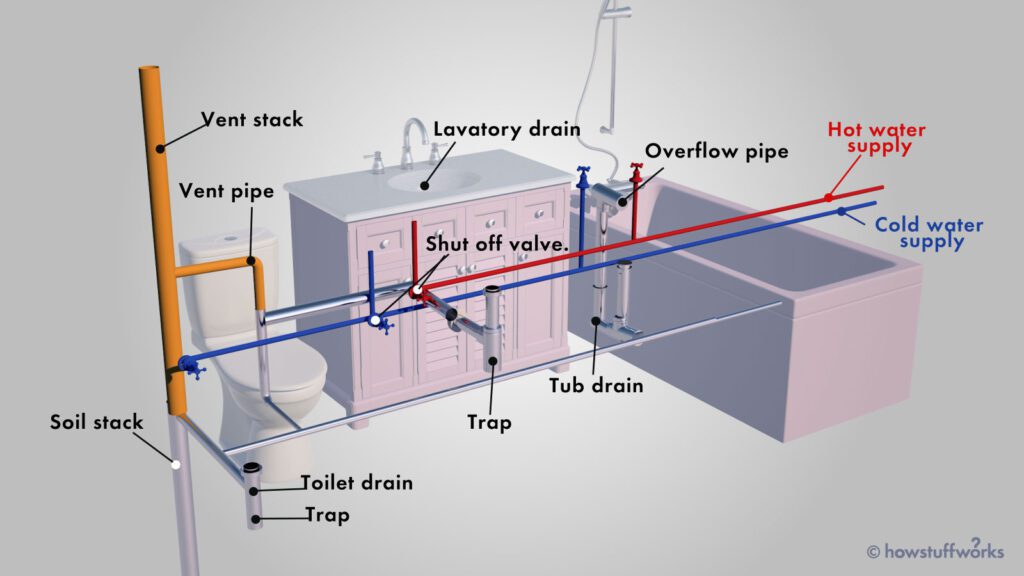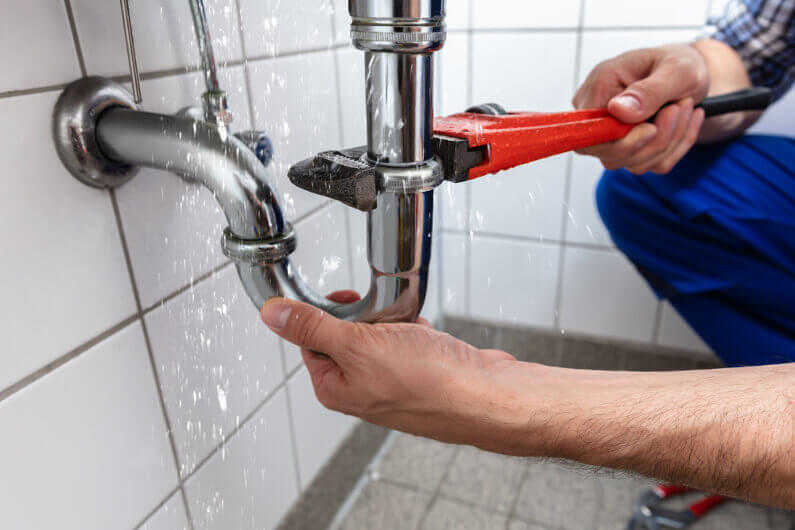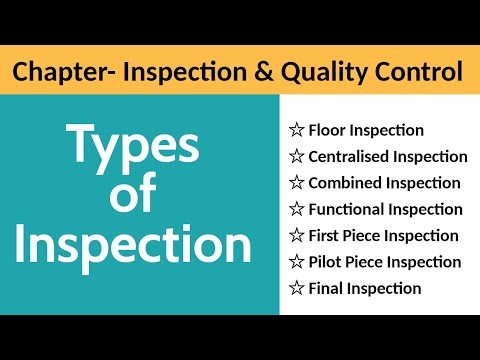You’re about to discover the essence of final inspection – a vital process in ensuring quality and compliance before a project’s completion. Between validating all requirements, inspecting every detail, and using thorough checks, final inspection serves as the last line of defense to guarantee that everything is in order and up to standard. Let’s explore what final inspection entails and why it plays a crucial role in various industries.


Definition
Explanation of final inspection
Final inspection refers to the last stage in the inspection process, where a thorough examination of a product, project, or property is conducted to ensure that it meets predetermined quality standards and compliance regulations. This critical step ensures that any defects or errors are identified and rectified before the product is released, the project is completed, or the property is handed over to the buyer or tenant.
Purpose of final inspection
The main purpose of final inspection is to ensure the overall quality, completeness, and readiness of the item being inspected. It serves as a final check to ensure that all the necessary requirements and specifications have been met, and that any potential issues or discrepancies are addressed before the final delivery or handover. The goal is to ensure customer satisfaction, minimize the risk of complaints or legal disputes, and maintain the reputation of the organization or individual involved.
When final inspection is conducted
Final inspection is typically conducted towards the final stages of a project, production process, or property transaction. The timing may vary depending on the specific industry or context. In manufacturing, it is performed after the goods have been assembled or manufactured. In construction, it takes place after the completion of all construction activities. In real estate, it occurs before the buyer takes possession of the property. Conducting the final inspection at the appropriate time is crucial to ensure accuracy and effectiveness.
Importance of Final Inspection
Ensuring quality and compliance
One of the primary reasons why final inspection is important is to ensure that the product, project, or property meets the required quality standards and compliance regulations. By conducting a meticulous examination, any potential issues or non-conformities can be identified and addressed before it is too late. This helps to prevent the release of substandard or non-compliant items, which could lead to customer dissatisfaction, legal consequences, or reputational damage.
Identifying defects and errors
Another significant importance of final inspection is its ability to identify defects and errors that may have occurred during the production, construction, or renovation process. No matter how carefully an item is manufactured or constructed, there is always a chance of mistakes or flaws. Final inspection provides an opportunity to detect and rectify such defects before the product is delivered, the project is completed, or the property is handed over to the buyer. This helps to uphold the quality and integrity of the final outcome.
Verifying completion and readiness
Final inspection determines whether an item is truly complete and ready for its intended use or purpose. It serves as a confirmation and verification process to ensure that everything is in order and there are no pending tasks or outstanding issues. By conducting this inspection, any remaining deficiencies, unfinished work, or missing components can be identified and addressed promptly. This step is crucial in meeting customer expectations, as it ensures that the final product, project, or property is in its desired state of completion before delivery or handover.


Final Inspection Process
Preparation
Before conducting the final inspection, adequate preparation is necessary to ensure its success. This includes gathering all relevant documents, blueprints, specifications, and regulatory requirements related to the item being inspected. It is also important to schedule the inspection at a suitable time and make any necessary arrangements with the involved parties. Adequate resources, such as inspection tools and equipment, should be prepared to facilitate the inspection process effectively.
Checklist
A comprehensive checklist is an essential component of the final inspection process. The checklist serves as a guide to ensure that all necessary aspects and requirements are thoroughly examined and evaluated. It helps the inspector to stay organized, focused, and systematic in their approach. The checklist may include items related to quality control, compliance, functionality, safety, aesthetics, and any other specific criteria relevant to the item being inspected.
Execution
Once the preparation and checklist are in place, the actual execution of the final inspection takes place. The inspector conducts a thorough examination of the item, carefully assessing all relevant aspects and criteria. This may involve visual inspections, measurements, tests, or any other applicable methods depending on the nature of the item. The inspector pays close attention to detail and ensures that all quality standards, regulatory requirements, and project specifications are met.
Documentation
Proper documentation is an essential part of the final inspection process. The inspector documents their findings, observations, and any non-conformities or defects discovered during the inspection. This documentation serves as a record of the inspection process and provides evidence of compliance or non-compliance. It is also useful for future reference, audits, or legal purposes. The documentation should be clear, concise, and accurately reflect the condition and status of the item at the time of inspection.
Final Inspection Checklist
Overview of a final inspection checklist
A final inspection checklist is a detailed list of items that need to be checked and evaluated during the final inspection process. It serves as a comprehensive guide for the inspector to ensure that all necessary aspects and requirements are covered. The checklist generally includes various criteria related to quality, compliance, functionality, safety, aesthetics, and other specific requirements depending on the industry or context.
Common items on a final inspection checklist
While the specific items on a final inspection checklist may vary depending on the industry or context, there are some common items that are often included. These may include checking for completeness of the item, verifying the accuracy of measurements and specifications, inspecting for any visible defects or damages, ensuring the functionality of all components, assessing adherence to safety standards, compliance with regulatory requirements, and confirming proper documentation is in place.
Tailoring the checklist to specific industries
It is important to customize the final inspection checklist based on the specific industry or context in which it is being used. Each industry has its own unique requirements, regulations, and quality standards that need to be addressed during the inspection. By tailoring the checklist to the specific industry, the inspection process becomes more relevant, accurate, and effective. This ensures that all industry-specific requirements are met and reduces the risk of overlooking critical aspects during the inspection.


Final Inspection in Manufacturing
Inspecting finished goods
In the manufacturing industry, final inspection involves the examination of finished goods before they are released for distribution or shipping. The inspector checks for any manufacturing defects, damages, or non-conformities that may have occurred during the production process. This includes assessing the overall quality, appearance, and functionality of the products. By conducting the final inspection, manufacturers can ensure that only high-quality products reach the market, reducing the risk of customer complaints or returns.
Verifying specifications and standards
Another important aspect of final inspection in manufacturing is verifying that the finished goods meet the specified specifications and industry standards. The inspector checks whether the products adhere to the required dimensions, weight, color, materials, or any other relevant specifications. This ensures that the products are consistent with the intended design and meet the expectations of the customers. Compliance with specifications and standards enhances product reliability, customer satisfaction, and overall market competitiveness.
Testing performance and functionality
In addition to visual inspections, final inspection in manufacturing often involves testing the performance and functionality of the finished goods. This may include conducting various tests, such as functionality tests, load tests, endurance tests, or any other applicable tests depending on the nature of the product. By evaluating the performance and functionality, manufacturers can ensure that the products meet the required performance standards and function as intended. This step reduces the risk of product failures or malfunctions, enhancing customer satisfaction and loyalty.
Final Inspection in Construction
Reviewing completed work
In the construction industry, final inspection is conducted to review the completed work before the project is considered finished and handed over to the client or owner. The inspector carefully assesses the entire construction project, both internal and external, to ensure that all work has been completed as per the agreed plans and specifications. This includes inspecting structural elements, finishes, utilities, and any other relevant aspects. By reviewing the completed work, construction companies can guarantee the quality and integrity of their construction projects.
Checking compliance with blueprints and plans
One of the key aspects of final inspection in construction is checking the compliance of the completed work with the original blueprints and plans. The inspector compares the actual construction to the approved drawings to identify any discrepancies or deviations. This includes verifying the accuracy of dimensions, configurations, materials, finishes, and any other relevant details. Ensuring compliance with the blueprints and plans is crucial to guarantee that the construction project meets the desired design and functional requirements.
Verifying adherence to safety regulations
Safety is a paramount concern in the construction industry, and final inspection plays a vital role in ensuring adherence to safety regulations. The inspector assesses the construction project to verify compliance with local building codes, safety standards, and regulations. This includes inspecting safety features, fire protection measures, electrical systems, and any other elements that contribute to a safe working and living environment. Verifying adherence to safety regulations minimizes the risk of accidents, injuries, or legal issues associated with non-compliance.
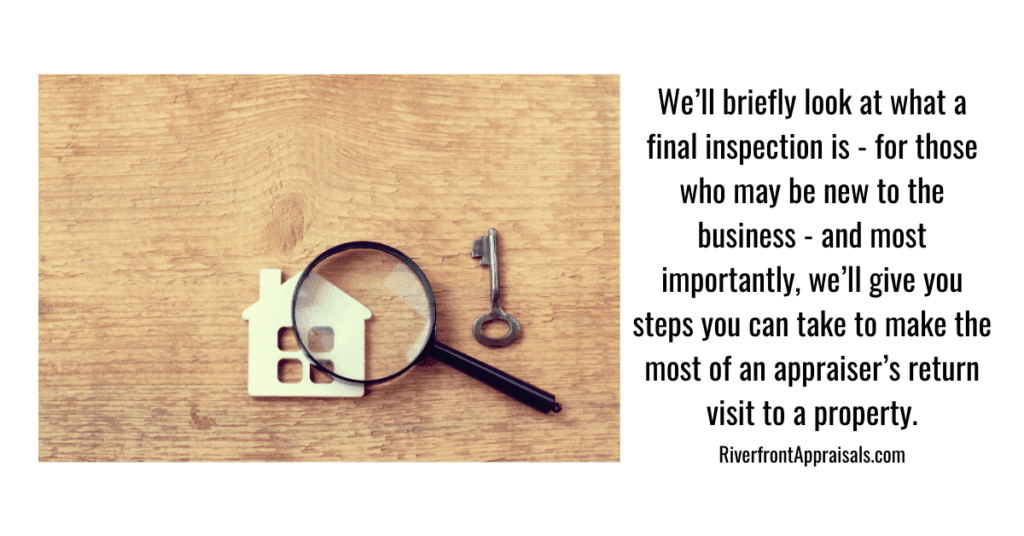

Final Inspection in Real Estate
Reviewing property condition
In the real estate industry, final inspection is conducted to review the overall condition of a property before it is sold or rented out. The inspector examines both the interior and exterior of the property, assessing its condition, cleanliness, and functionality. This includes evaluating the condition of walls, floors, doors, windows, plumbing, electrical systems, and any other elements that contribute to the habitability and usability of the property. By reviewing the property condition, real estate professionals can ensure that the property is in suitable condition for the new occupants.
Checking for necessary repairs or renovations
During the final inspection in real estate, the inspector identifies any necessary repairs or renovations that need to be addressed before the property is handed over to the buyer or tenant. This includes assessing the condition of fixtures, appliances, HVAC systems, and any other elements that may require maintenance or replacement. Identifying necessary repairs or renovations allows real estate professionals to address these issues and ensure that the property is in optimal condition for the new occupants.
Verifying completion of contractual agreements
Final inspection in real estate also involves verifying the completion of any contractual agreements or obligations between the parties involved. The inspector ensures that all agreed-upon terms, repairs, or upgrades have been completed before the property is transferred to the new owner or tenant. This includes confirming the fulfillment of any repair requests, the installation of new fixtures, or the completion of any renovations as specified in the contract. Verifying the completion of contractual agreements avoids misunderstandings or disputes between the parties involved.
Benefits of Final Inspection
Quality assurance
One of the key benefits of final inspection is ensuring quality assurance for the product, project, or property being inspected. By conducting a detailed examination and verification process, any potential issues, defects, or non-compliances can be identified and rectified, ensuring that the final outcome meets the desired quality standards. Quality assurance enhances customer satisfaction, reduces the risk of complaints or returns, and strengthens the overall reputation and credibility of the organization or individual involved.
Customer satisfaction
Final inspection plays a crucial role in ensuring customer satisfaction. By conducting a thorough inspection and addressing any potential issues or deficiencies, organizations can deliver a high-quality product, project, or property that meets or exceeds customer expectations. This leads to higher levels of customer satisfaction and loyalty, as customers feel confident in the reliability, functionality, and safety of their purchase or investment. Satisfied customers are more likely to recommend the product or service to others, contributing to the success and growth of the organization.
Risk mitigation
Final inspection serves as a risk mitigation measure for organizations and individuals involved in the production, construction, or real estate industry. By identifying and rectifying any potential defects, errors, non-compliances, or safety concerns before the final delivery or handover, the risk of legal disputes, customer complaints, or financial losses is significantly reduced. Moreover, conducting a robust and systematic inspection process demonstrates a commitment to quality and compliance, which can help mitigate the risk of reputational damage or negative publicity.
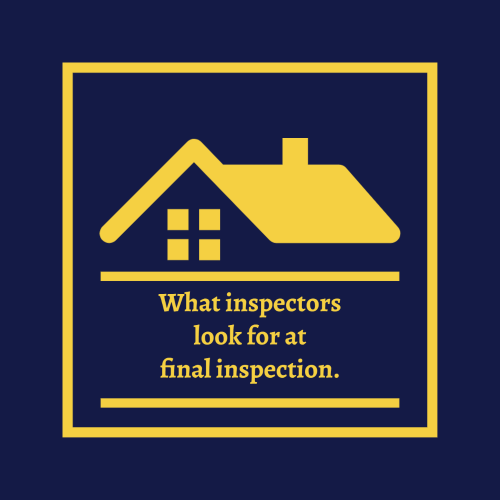

Challenges in Final Inspection
Human error
One of the primary challenges in final inspection is the possibility of human error. Inspectors, just like any other individuals, may make mistakes or fail to notice certain defects, especially if they are fatigued, distracted, or under pressure. Human error can lead to oversight of critical issues or inaccuracies in the inspection process, compromising the quality and effectiveness of the final inspection. To mitigate this challenge, organizations should invest in proper training, oversight, and quality control measures to minimize the risk of human error.
Time constraints
Final inspection is often conducted within a specific timeframe, which can pose challenges in conducting a thorough and comprehensive examination. Inspectors may face time constraints, especially when dealing with large-scale projects or properties. Limited time may result in a rushed inspection process, leading to incomplete evaluations or the possibility of overlooking critical aspects. Adequate planning, allocation of sufficient time, and effective time management strategies can help address this challenge and ensure a thorough final inspection.
Consistency
Maintaining consistency in the final inspection process can be challenging, especially if multiple inspectors or individuals are involved. Ensuring uniformity in judgment, evaluation, and decision-making throughout the inspection process is crucial to guarantee accurate and reliable results. Consistency can be compromised if different inspectors have varying levels of experience, training, or interpretation of the inspection criteria. Organizations should establish clear guidelines, standardize inspection procedures, and provide adequate training to promote consistency in the final inspection process.
Improving Final Inspection Process
Automation and technology
To improve the final inspection process, organizations can leverage automation and technology. The use of advanced inspection tools, equipment, and software can enhance the accuracy, efficiency, and consistency of the inspection process. Automation can eliminate human error, streamline data collection and analysis, and facilitate real-time reporting and documentation. By embracing automation and technology, organizations can improve the quality, speed, and effectiveness of the final inspection, leading to better outcomes and customer satisfaction.
Employee training and education
Investing in comprehensive training and education for inspectors is essential to enhance the final inspection process. Inspectors should have a solid understanding of relevant industry standards, regulations, and quality requirements. They should be trained in effective inspection techniques, data collection methods, and documentation procedures. Ongoing education and continuous professional development programs can keep inspectors updated on the latest practices, technologies, and industry trends. Well-trained and knowledgeable inspectors are more likely to conduct thorough and accurate final inspections.
Continuous improvement
Implementing a culture of continuous improvement is crucial to enhance the final inspection process. Organizations should encourage feedback and suggestions from inspectors, supervisors, and other stakeholders involved in the process. Regular review and evaluation of the inspection procedures, checklist, and documentation can help identify areas for improvement and implement corrective actions. By continuously seeking ways to improve the final inspection process, organizations can enhance the overall quality, efficiency, and effectiveness, leading to better outcomes for all parties involved.
In conclusion, final inspection is a critical step to ensure the quality, completeness, and readiness of a product, project, or property before its delivery or handover. It plays a crucial role in assuring quality and compliance, identifying defects and errors, and verifying completion and readiness. The final inspection process involves adequate preparation, checklist creation, execution, and documentation. A comprehensive final inspection checklist ensures that all relevant aspects and requirements are thoroughly examined. Final inspection is important in various industries, including manufacturing, construction, and real estate, where it serves specific purposes tailored to each industry’s needs. It offers benefits such as quality assurance, customer satisfaction, and risk mitigation. However, challenges such as human error, time constraints, and maintaining consistency need to be addressed. Organizations can improve the final inspection process through automation and technology, employee training and education, and fostering a culture of continuous improvement. By prioritizing final inspection, organizations can ensure that they deliver products, projects, or properties that meet the highest quality standards and exceed customer expectations.



